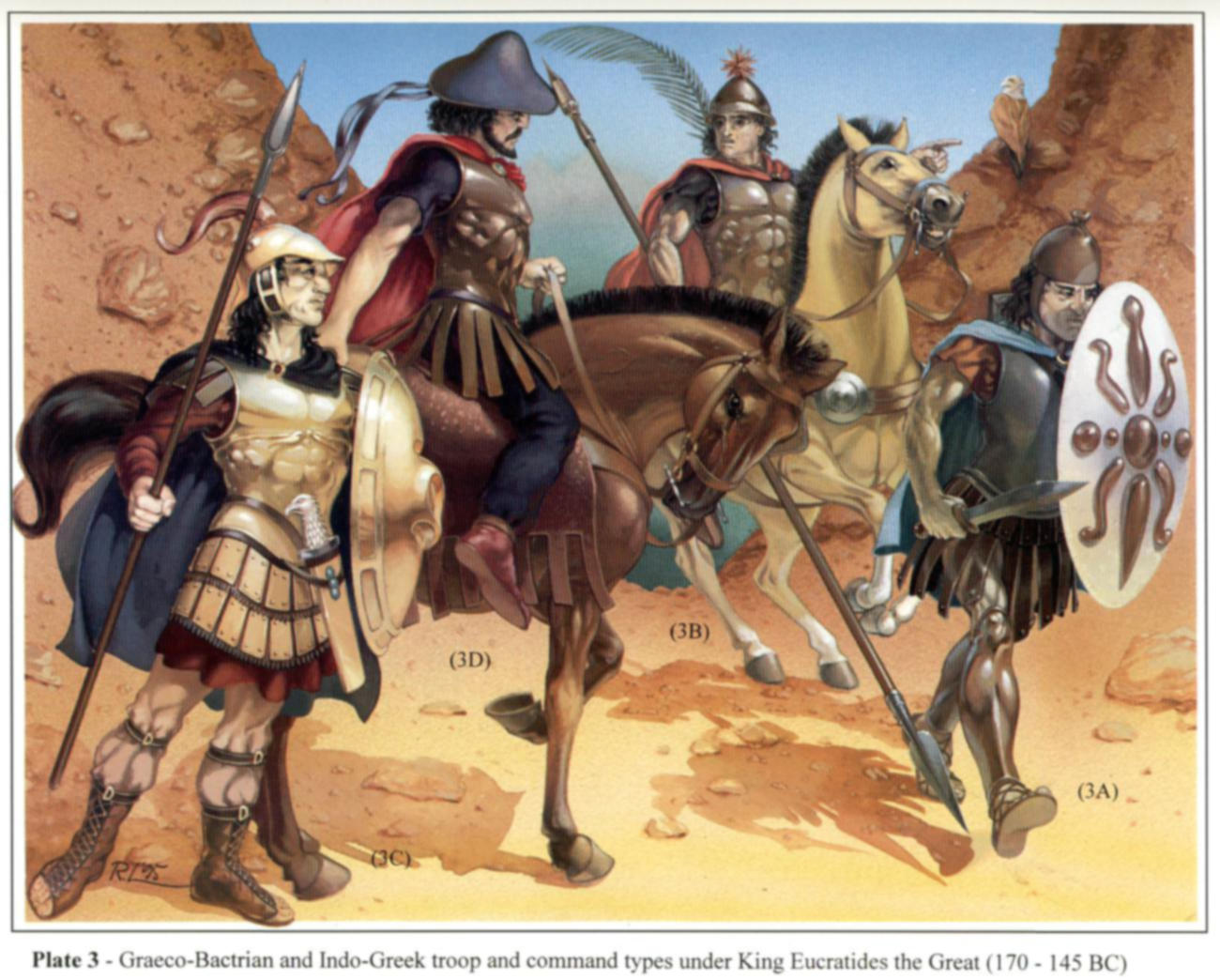Try Amazon Audible Plus

Register a SNAP EBT card with Amazon
Plate 3 - Graeco-Bactrian and Indo-Greek troop and command types under King Eucratides the Great (170 - 145 BC) in The Armies of Bactria 700BC-450AD
Volume 2 (Illustrations) by Valerii P Nikonorov. Colour Plates by Rory Little

Plate 3 - Graeco-Bactrian and Indo-Greek troop and command types under King Eucratides the Great (170 - 145 BC)
(3A) Armoured foot soldier of the thyreophoros type
(3B) Heavy lancer (sarissophorus) of Eucratides' mounted bodyguard
(3C) King's foot bodyguard
(3D) Indo-Greek general on horseback
This plate deals with warrior types acting in the time of the mighty king Eucratides the Great, who reigned not only over Bactria but also over some territories to the south of the Hindukush.
The foot solder (3A) based on the terracotta plaque from Kampyr-tepe (Fig 24a) is shown wearing a spiked helmet of bronze,
plain (not "muscle") cuirass of iron provided with a stand-up collar, thigh-protector of the pteryges type and bronze greaves-knemides.
He carries a short Greek sword with iron blade of stretched rhomboid form (xiphos).
His large oval shield goes back, most likely, to the typical Celtic thyreos,
though such a distinctive feature of the latter as a spindle-shaped boss is replaced here by a massive emblem of metal in relief,
which possibly depicts a lizard; this emblem has perhaps not only a decorative function but also a strengthening one like the spindle-shaped boss of the thyreos.
The cavalryman (3B) is reconstructed after depictions on
Eucratides' coins which show on the reverse the heavenly twins Dioscuri charging with very long lances-sarissae (Fig 19b).
The Dioscuri were usually represented in Hellenistic and Roman art as nude men, without any body-armour.
In reality such mounted lancers, whose function was to fight in close combat, had to wear corselets, so our rider has a Greek "muscle" cuirass well adapted to cavalry usage.
Besides that, he also wears a bronze conical helmet of the "Pilos" type, which was peculiar to the Dioscuri iconography of Eucratides' coins (see Fig 8g),
and pteryges-type thigh-protector.
His sarissa, about 4.5m long, is provided with an iron butt-spike (here after Fig 8b, but compare 8k,l).
It seems quite possible that the Dioscuri on the coins of Eucratides copy,
to some extent, horsemen of the king's bodyguard picked regiment, 300 in number, as described by Justinus (XLI,6,4).
Although the palm on his back and the star on his helmet are very unlikely, if not impossible, for an actual warrior, as opposed to one of the heavenly twins,
we have decided still to portray them in our reconstruction.
The foot bodyguard (3C) is based upon the two gold clasps from Grave no 3 of the Tillya-tepe necropolis (Fig 24e,f).
Although this burial is dated itself to the first half of the 1st century AD, the pieces under review seem to be of much earlier date.
Most probably, they were manufactured by a local master, either in the Late Graeco-Bactrian or in the very Early Yüeh-chih period,
that is within the second half of the 2nd century BC.
In any case, most of our warrior's outfit, particularly a helmet of the "sharp forehead peak" type,
elaborately produced "muscle" cuirass and short sword with a hilt shaped into the griffin's head,
are of obvious Hellenistic origin.
Deserving attention is the method of suspending the sword - by means of the scabbard-slide.
Assuming our dating is correct, then we are witnessing the earliest use of the scabbard-slide in the Bactrian region.
Taking into account the parade aspects of both the warriors on the clasps,
it seems acceptable to depict the whole armour assemblage on our reconstruction as made of gilt metal.
The mounted general (3D) is based upon coin representations of the Indo-Greek ruler Antimachus II Nicephorus (Fig 19d).
He wears a broad-brimmed hat of cloth or felt, probably the Graeco-Macedonian petasos.
His armour consists of a "muscle" cuirass of bronze, added here hypothetically, and thigh-protector of the pteryges type.
Worthy of note is his horse's long saddle-cloth with the lower edge decorated with a crenellated ornament.
On the whole, this figure's outfit is rather for the march than the battle.
Source: The Armies of Bactria 700BC-450AD Volume 2 (Illustrations) by Valerii P Nikonorov
See also Bactrian Greek Terracotta Plaque of a Warrior, Kampyr-tepe.
Bactrian Greek Coins
Plate 4 Yüeh-chih cavalry in The Armies of Bactria 700BC-450AD Volume 2 (Illustrations) by Valerii P Nikonorov. Colour Plates by Rory Little
Plate 5 Bactrian nobles in The Armies of Bactria 700BC-450AD Volume 2 (Illustrations) by Valerii P Nikonorov. Colour Plates by Rory Little
Plate 7 Gandharan warriors in The Armies of Bactria 700BC-450AD Volume 2 (Illustrations) by Valerii P Nikonorov. Colour Plates by Rory Little
Other Ancient Illustrations of Costume and Soldiers


